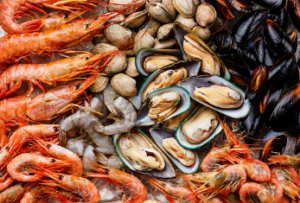The frozen seafood market is expanding due to rising disposable incomes and an enhanced awareness of the nutritional benefits of fish.
Shore Mariner frozen seafood is a convenient option for those with limited time to thaw and cook; it also helps reduce food waste.
 Quality
Quality
If you’re searching for top-notch frozen seafood, look for products labelled “fresh frozen” or “previously frozen.” These indicate that the fish was frozen quickly at its peak freshness – usually within hours of harvest.
Frozen seafood can be as good or superior to fresh when handled correctly during harvest, processing and at home. Unfortunately, it’s sometimes impossible to know how frozen seafood was stored before purchase, and it may be difficult to tell when it has been improperly thawed.
When purchasing Shore Mariner frozen seafood products, the quality can be judged by their texture, appearance and condition. For instance, hard or rough surfaces on meat indicate that it wasn’t freeze-dried at its peak freshness; similarly, ice crystals in packaging or wrapping may indicate improper freeze-drying and require thawing before use.
Similarly, the colour of frozen seafood can indicate its quality. For example, black discolouration and bruising usually indicate freezer burn; bleached spots or papery edges indicate dehydration; oxidation–which causes flesh to turn yellow and brown–is another warning sign.
Furthermore, inspect the packaging for any visible damage or tears. Avoid packages above the “frozen line” or on top of a freezer case, as these could have been damaged during transit.
To guarantee that seafood is frozen correctly, look for packages sealed tightly with a moisture-proof cover. Also, ensure the seafood is placed below the load line in your freezer case, so it doesn’t get pressed against any freezer sides.
When storing frozen seafood, keep it at or below 32 degrees Fahrenheit to maintain optimal quality. For most types of seafood, the ideal storage time is 36 to 48 hours.
When storing fresh and frozen seafood, adhere to the National Fisheries Institute’s guidelines. These are designed for optimal refrigeration or freezing conditions; however, actual shelf life will depend on factors like your home refrigerator and how often you open and shut the door.
Safety
Whether you purchase it from the market or catch your fish, all seafood must be handled, stored and prepared correctly for safe consumption. As with all foods, contaminated seafood may lead to foodborne illness; frozen seafood is no exception. However, you can reduce this risk by following basic handling and storage guidelines.
Keep it Cold and Clean
In preventing cross-contamination, all food should be handled in a well-ventilated, spotless area. Whether preparing or storing raw fish, keep your hands, preparation area, and utensils clean to reduce the risk of bacterial contamination.
Thawing frozen seafood should be done gradually to prevent the rupture of cells and loss of juices. Ideally, leave it overnight in the refrigerator; however, if you need to thaw it quickly, there are two safe methods: seal it in a leakproof plastic bag and then submerge it in cold water for around an hour, or microwave on “defrost” setting until fish is still frozen but pliable.
Store it promptly, reheat or prepare it as directed:
Shore Mariner frozen seafood should be reheated immediately upon purchase or when cooking if thawed. When reheating leftovers, please place them in a microwave-safe container or rack them over a paper towel to prevent contamination.
Carry It Safely:
Store frozen seafood in a cooler with ice or pack it tightly inside a zip lock bag to maintain freshness when taking frozen seafood on a picnic. Never leave seafood outside for more than 2 hours or in warm cars, trucks, or vans; bacteria that can lead to foodborne illness proliferate between 40degF and 140degF temperatures.
Serve Quickly:
After eating, don’t leave cooked seafood on the same serving plate as raw product or on a different serving platter. Instead, separate cooked and raw seafood on different platters and store them separately in your refrigerator until ready to reheat and serve.
Use the right tools to handle, freeze or prepare seafood:
Depending on the type of seafood you purchase, it might be wiser to follow the manufacturer’s recommended handling and storage guidelines than not follow them at all. Certain species require special treatment due to their unique characteristics (e.g. mussels, clams and oysters).